Join getAbstract to access the summary!

Join getAbstract to access the summary!
Joseph C. H. Chai
China
Transition to a Market Economy
Oxford UP, 1997
What's inside?
China’s transition from a planned economy to a market economy isn’t as great as it may seem from outside, or as erratic as it may seem from the inside.
Recommendation
China is still an enigma to many business people and investors who wonder about the extent to which the country really will participate in a market economy. This book provides a strong, yet concise, review of the history and results of China’s transition from a planned economy to a market economy. Author Joseph C. H. Chai covers the Chinese government’s reform efforts across several economic sectors, including agricultural, industrial, financial, trade liberalization and foreign direct investment. The chapter on non-state sector business fully rounds out Chai’s portrait of the current state of the Chinese economy. getabstract.com recommends this fascinating book to anyone who wants a scholarly review of the economic issues facing China before, during and after market economy reforms. The better your knowledge of economics, the more useful this book will be to you, but even so, it will intrigue any reader who has more than a passing interest in China.
Summary
About the Author
Joseph C. H. Chai is senior lecturer in economics at the University of Queensland. Previously, a Research Fellow at Centre for Chinese Studies, Oxford University, and the Harvard-Yenching Institute, Harvard University, he has also been senior lecturer in economics at the University of Hong Kong.
















Comment on this summary